oil pressure sender calibration widget
#21 Re: oil pressure sender calibration widget
That was my solution Chris, and I'm very happy with my mechanical guage. However, I believe some want to stick with the old set up either for originality, or because they are worried that a failure of the mechanical guage joints could lead to oil everywhere.
Malcolm
I only fit in a 2+2, so got one!
1969 Series 2 2+2
2009 Jaguar XF-S
2015 F Type V6 S
I only fit in a 2+2, so got one!
1969 Series 2 2+2
2009 Jaguar XF-S
2015 F Type V6 S
| Link: | |
| BBcode: | |
| HTML: | |
| Hide post links |
#22 Re: oil pressure sender calibration widget
The original oil pressure gauge isn't driven by the voltage regulator, it's driven by the battery voltage so it makes no difference whether you've got a mechanical or electronic instrument voltage regulator.ralphr1780 wrote: ↑Tue Mar 08, 2022 11:49 amI have upgraded to electronic 10v regulator long time ago and the gauges reading became much more consistent.MarekH wrote: ↑Tue Mar 08, 2022 10:07 amPower will come directly from the unregulated supply. The old 10v regulators are nothing but on:off switches so are unsuitable sources of power for anything but a bimetallic strip gauge, so the widget and gauge will have their own supply independent of the old 10v "regulator".
The drawing in post 15 is incorrect, the oil pressure gauge should go to the "B connection on the voltage regulator the same as the voltmeter.
John
1969 Series 2 FHC
1969 Series 2 FHC
| Link: | |
| BBcode: | |
| HTML: | |
| Hide post links |
#23 Re: oil pressure sender calibration widget
The original design had the oil pressure gauge/sender powered from the “B” connection because back then the oil pressure senders were voltage independent bi-metallic switching types. Such are NLA, these days all you can buy are resistive type senders, these are very effected by voltage so, for consistent performance when using a resistive sender, the gauge should be powered from the “I” connector. Note that the sender is drawn as a resistive type.
Powering the gauge/sender from the “I” connector would make the gauge consistent however it will also reduce the indicated pressure, because voltage is lower, “B” voltage is typically 11-13 V, “I” voltage is 10 V. To resolve this you would need a different sender or Marek’s widget. Either way, if it is a resistive type sender, the voltage supply should be regulated.
Using S3 as example:
Original bimetallic switching type of sender was a Smiths Instruments PT1811-10 (has a double lug electrical connector in the middle). The Jaguar part number was C31177. Now when you purchase a C31177 you will most likely be sent a PTR1811-10 (R = resistance, has a single lug electrical connector that is off-centre). Despite the common Jaguar part number “PTR” senders have completely different principle, performance and requirements compared to the original “PT” senders.
The “10” in the above sender designations signifies 100 psi, this is the pressure that will cause your gauge to indicate full scale. The S3 gauge full scale is 80 psi therefore, with everything working as intended, when the oil pressure is 100 psi the gauge should read 80 psi. This is demonstrated by the following test results: The two Smiths senders are 100 psi so when 90 psi is applied the S3 gauge indicates 75 psi. The VDO sender is 80 psi, same as the gauge, so when 90 psi is applied the S3 gauge indicates 90 psi.
The above results were with the gauge connected to the “B” connector, voltage was 12.4 V. When swapped to the “I” connector (=10 V) the gauge indication reduced correspondingly, i.e., with the Smiths senders, when 90 psi was applied the gauges displayed 75 psi when connected to “B” and 55 psi when connected to “I”. This suggests that, for S3's with resistive senders supplied from a regulated (10 V) supply the ideal Smiths sender might be a PTR1801-06, Jaguar part number C15474?
I reckon in the e-type world there are 3 owner categories:chrisallen01 wrote: ↑Tue Mar 08, 2022 8:13 pmI simply replaced the dodgy sender unit and electric gauge with a very similar mechanical gauge
1st category, those who have already installed a mechanical gauge and are smugly confident that if they hooked it up to an air compressor, the gauge indications would be the same;
2nd category, those with an electrical gauge who realise its best to stay ignorant about its inaccuracy;
3rd category, those who would be content with a diy installable widget that was relatively inexpensive/convenient to implement, compared to a mechanical gauge, just needing a bicycle pump to calibrate it.
4th category, not statistically significant, is the bloody-minded, of which I am one.
Here are my test results. Bench test, i.e. everything out of the car:

Battery voltage = 12.44-12.45 V, the later with afternoon sun through the window.
As per photo, because my senders are all resistive type I started with voltage regulator (10V) in the circuit. However the relatively slow switching by the regulator made multimeter reading too difficult so I removed the regulator. At 90 psi with 1001-10DEC sender, gauge reading increased 20 psi when the regulator was removed (from 55 to 75 psi), would be even higher when there is alternator voltage (~13.6 V). Such voltage dependency is why voltage regulators are used with resistive type senders, for consistent, reliable reading.
One gauge, 3 senders: (1) Smiths PTR-1001-10DEC, (2) Smiths PTR- 1811-10, (3) VDO 360-801.
Measured the voltage across the sender; more stable than measuring across the bi-metallic gauge. Voltage across the gauge is then the battery voltage minus the sender voltage.
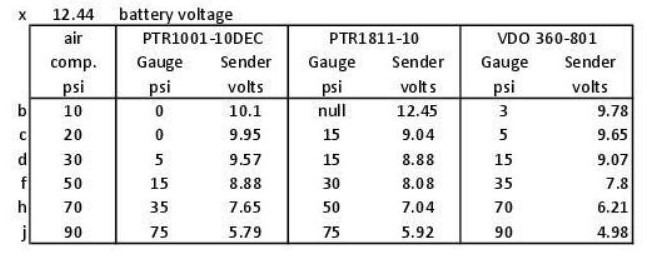
Regards,
ColinL
'72 OTS manual V12
ColinL
'72 OTS manual V12
| Link: | |
| BBcode: | |
| HTML: | |
| Hide post links |
-
chrisallen01
- Posts: 59
- Joined: Thu Mar 06, 2014 9:01 pm
- Location: United Kingdom

#24 Re: oil pressure sender calibration widget
Hi Colin,
I'm definitely in the !st category, smugly watching my oil pressure rise and fall in proportion to the engine speed and temperature but I've utilised an Aeroquip type pipe to connect to the gauge and used the redundant wire to drive a low engine oil press red light (LHD series 2) on the dash just above the heater controls as a mirror image of the choke warning light.
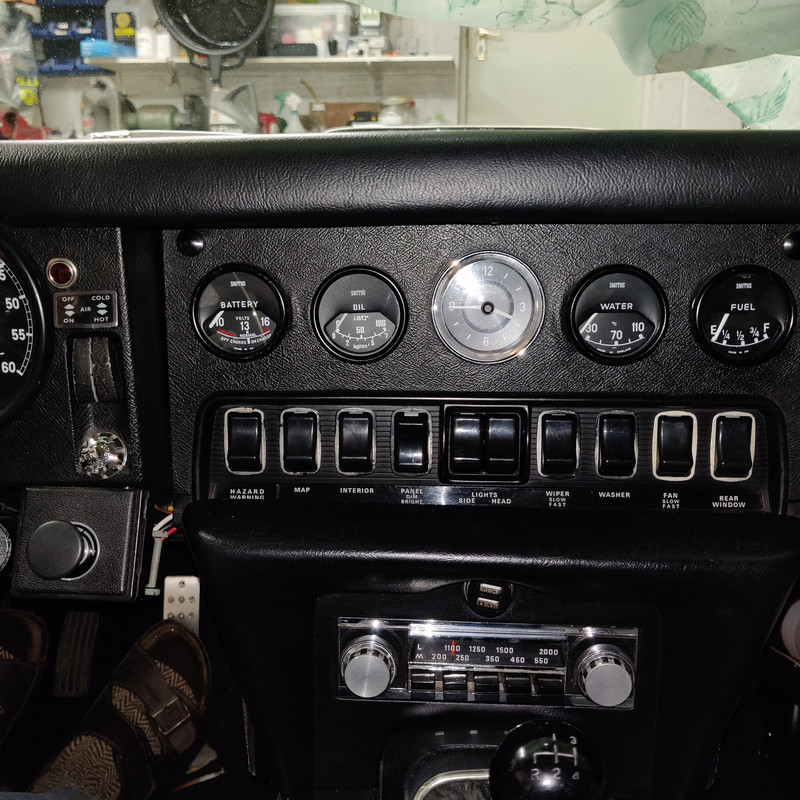
I'm definitely in the !st category, smugly watching my oil pressure rise and fall in proportion to the engine speed and temperature but I've utilised an Aeroquip type pipe to connect to the gauge and used the redundant wire to drive a low engine oil press red light (LHD series 2) on the dash just above the heater controls as a mirror image of the choke warning light.

Chris
69 S2 FHC OEW P1R27068
Oxford UK
69 S2 FHC OEW P1R27068
Oxford UK
| Link: | |
| BBcode: | |
| HTML: | |
| Hide post links |
#25 Re: oil pressure sender calibration widget
These guys do a capillary gauge that is pretty close to the original. Needle is ever so slightly shorter. We only fit these now.
https://www.caigauge.com/
https://www.caigauge.com/
Angus 67 FHC 1E33656
61 OTS 875047
61 OTS 875047
| Link: | |
| BBcode: | |
| HTML: | |
| Hide post links |
#26 Re: oil pressure sender calibration widget
Very informative post Colin. Thank you.
If people are uncertain as to whether their gauge is of a bimetallic switch type or a resistive gauge, just connect an LED in between the gauge and sender and feed it from the unregulated supply. If it lights up solid, it's a resistive sender; if it strobes, it's a bimetallic sender.
To give a worked example of how the widget would work, it is easiest to look at the third sender. This needs no basic overall multiplier as it reads correctly at high values 70-90psi - it just needs a regulated supply of 12.45 for that to always hold good - that's easy to arrange and will be part of the widget. Below 70, it needs boosting.
How much does it need boosting?
Well, the next compressor reading at 50psi reads low at 35psi, so if we add a linear adjustment to all values below 70psi, starting with no adjustment at 70psi, but with a triangle shaped wedge of cheese adjustment which gets progressively bigger as we go towards 0psi, then we'll need a 150% adjustment. That's because the indicated 35 gets multiplied by [1+ (1.5 x (70-50)/70)], i.e. 50 pops out !!!
All of the gauges readings further towards zero are going to also get a boost, so the
indicated 15 becomes 27.9 (it gets multiplied by [1+(1.5 x (70-30)70)] ) and
indicated 5 becomes 10.4 (it gets multiplied by [1+(1.5 x (70-20)70)] ) and
indicated 3 becomes 6.9 (it gets multiplied by [1+(1.5 x (70-10)70)] because 10psi is 6/7 of the way to zero
Then you repeat the process with the next lower down wrong reading by setting the air compressor to the next reading down and twiddling the next knob .
With just one adjustment, it's already a lot closer.
kind regards
Marek
If people are uncertain as to whether their gauge is of a bimetallic switch type or a resistive gauge, just connect an LED in between the gauge and sender and feed it from the unregulated supply. If it lights up solid, it's a resistive sender; if it strobes, it's a bimetallic sender.
To give a worked example of how the widget would work, it is easiest to look at the third sender. This needs no basic overall multiplier as it reads correctly at high values 70-90psi - it just needs a regulated supply of 12.45 for that to always hold good - that's easy to arrange and will be part of the widget. Below 70, it needs boosting.
How much does it need boosting?
Well, the next compressor reading at 50psi reads low at 35psi, so if we add a linear adjustment to all values below 70psi, starting with no adjustment at 70psi, but with a triangle shaped wedge of cheese adjustment which gets progressively bigger as we go towards 0psi, then we'll need a 150% adjustment. That's because the indicated 35 gets multiplied by [1+ (1.5 x (70-50)/70)], i.e. 50 pops out !!!
All of the gauges readings further towards zero are going to also get a boost, so the
indicated 15 becomes 27.9 (it gets multiplied by [1+(1.5 x (70-30)70)] ) and
indicated 5 becomes 10.4 (it gets multiplied by [1+(1.5 x (70-20)70)] ) and
indicated 3 becomes 6.9 (it gets multiplied by [1+(1.5 x (70-10)70)] because 10psi is 6/7 of the way to zero
Then you repeat the process with the next lower down wrong reading by setting the air compressor to the next reading down and twiddling the next knob .
With just one adjustment, it's already a lot closer.
kind regards
Marek
| Link: | |
| BBcode: | |
| HTML: | |
| Hide post links |
#27 Re: oil pressure sender calibration widget
Hi Angus,1954Etype wrote: ↑Thu Mar 10, 2022 7:23 pmThese guys do a capillary gauge that is pretty close to the original. Needle is ever so slightly shorter. We only fit these now.
https://www.caigauge.com/
When digging into your link it leads to the site of Smiths-Instruments.co.uk that does not seem to offer products directly for sale.
Could you share your link to purchase such a capillary gauge from an actual vendor? (I am worried by possible low quality of some "Smiths" gauges sold by a number of suppliers)
Serge
1964 (3.8) FHC
1961 OTS
1964 (3.8) FHC
1961 OTS
| Link: | |
| BBcode: | |
| HTML: | |
| Hide post links |
#28 Re: oil pressure sender calibration widget
Hi Serge, try calling them on 01639 732200. I think the quality is excellent and matches the original. I would post some photos but can't. Let me know if you need any more info.
Angus 67 FHC 1E33656
61 OTS 875047
61 OTS 875047
| Link: | |
| BBcode: | |
| HTML: | |
| Hide post links |
#29 Re: oil pressure sender calibration widget
I would support the comment by Angus. Give them a call. It’s not in the website. Ive got one of their capillary gauges ( reading up to 60psi) indistinguishable from the original and at a much better price than from the usuals.
Tim
Tim
Series 1 FHC purchased 40 years ago. Courted my wife in it.
Series 1 2+2 when the kids were small now sold.
Series 1.5 OTS in opalescent maroon, Californian car. My retirement present.
Series 1 2+2 when the kids were small now sold.
Series 1.5 OTS in opalescent maroon, Californian car. My retirement present.
| Link: | |
| BBcode: | |
| HTML: | |
| Hide post links |
#30 Re: oil pressure sender calibration widget
Thank you Angus and Tim.
Will contact them.
Will contact them.
Serge
1964 (3.8) FHC
1961 OTS
1964 (3.8) FHC
1961 OTS
| Link: | |
| BBcode: | |
| HTML: | |
| Hide post links |
#31 Re: oil pressure sender calibration widget
Chris, its interesting that you have a 100 psi mechanical gauge. In classic Jaguar style I only know of the Caerbont/Smiths Instruments 60 psi one. Is yours a one-off, cobbled together by someone clever?chrisallen01 wrote: ↑Thu Mar 10, 2022 7:19 pmsmugly watching my oil pressure rise and fall in proportion to the engine speed and temperature
And yes, imo the main (very seductive) benefit of a mechanical gauge is its ability to indicate pressure variations in almost real time; an old style electric bi-metallic gauge can never do this.
The three senders tested in post #23 are all brand new. The VDO sender I can’t use because it is too tall to fit in my preferred position under the left hand exhaust manifold. The sender normally sold as the “correct” Jaguar C31177 replacement (= PTR1811-10), as well as the illustrated inaccuracy, switches off (open circuit) at anything below 25 psi. The third sender, PTR1001-10DEC is what is sold as a Jaguar part C46272 (for the last xj6, xj12 also xjs, xj40.) It seems the most inaccurate. My understanding is that all of these senders are supposed to be in accordance with the applicable industry standard, 0..100% = 240..33 ohms. For the Smiths senders such compliance appears inconsistent and coincidental.
My conclusion, once an original sender has died, there is not any existing replacement that enables a classic Smiths electric gauge to display with tolerable accuracy; this is the case for a “widget”?
My interpretation, widget would be pre-calibrated by removing & connecting my sender to an air compressor and tweaking dials on the widget, until oil pressure gauge indication matches the pressure shown on the air compressors’ gauge? Reservations I would have, not sure if any of the senders I have experienced would be worthy, like putting lipstick on a pig?
Alternatively, how about a widget that requires virtually no calibrating, because it is only for a particular excellent pressure transducer? I would propose this be a Bosch 0261230340: state of-the art, reputable quality, popular, readily available, relatively inexpensive, includes temperature sensing, I’ve already bought one.
https://www.efihardware.com/download/178/H-PS150G-AT-B
I imagine a widget that would: be powered from a solid state voltage regulator (10 v); supply 5 V to the transducer; receive 0-5 V oil pressure signal from the transducer; send a 2-10 V power supply to the oil pressure gauge that is proportional to the oil pressure signal; include means (jumper switches?) for selecting the gauge range (s1/s2 = 60 psi, s3 = 90 psi, xjs = 100 psi); include means (pot?) for fine adjustment of the needle zero pressure position (ignition on engine off).
I.e.:
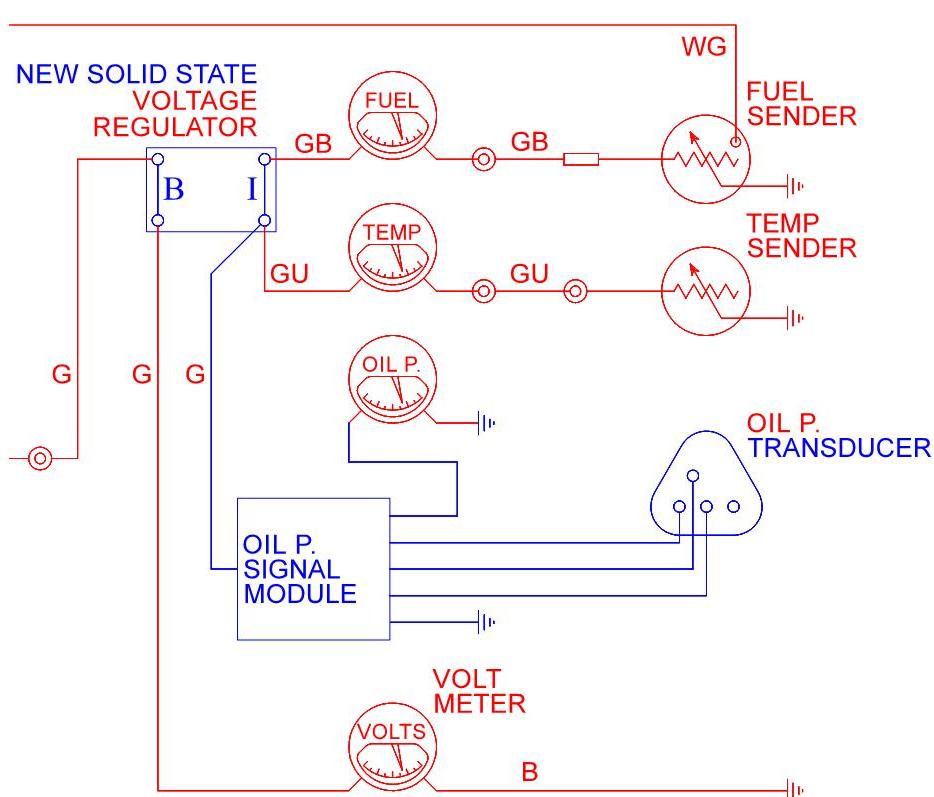

Might any of this be even remotely feasible?
Regards,
ColinL
'72 OTS manual V12
ColinL
'72 OTS manual V12
| Link: | |
| BBcode: | |
| HTML: | |
| Hide post links |
#32 Re: oil pressure sender calibration widget
You've made a lot of points there and most of it sounds very sensible Colin.
Given Malcolm's meme response, I also would expect to precalibrate the gauge driver - that's why I asked for a voltage table. What you have to remember is that we are dealing with voltages and not PSI, so it is the voltages which are being manipulated, not pressures.
The reason for using the widget is that 1/ everything still looks stock, 2/ you don't need to keep repurchasing senders every few years as you can simply recalibrate any time you like, and 3/ it'd cost less than a new sender. Wet gauges are a great idea, but are more work than plugging in some electrics and twiddling a dial.
Your proposed Bosch sender is problematic in that you will either have to find two additional spare wires to go from the dash gauge & widget through the firewall and on to the sender OR put the widget next to the sender, worry about its earthing and then have a separate power supply for the gauge. This isn't necessarily as straightforward as you think.
Having a single calibration widget that only works with a single defined sensor is pretty much the situation everyone is in now, so doesn't offer anything that a precalibrated normal widget doesn't.
For your gauge which purportedly is a 240 -33 ohm gauge but reads nothing below 25psi, make a resistance versus PSI table. The sender may work below 25psi but the gauge may not be capable of displaying anything useful at the low end of the range. Knowing what resistance your gauge is would also be useful. To do that, disconnect one (or both) gauge spade connections and measure resistance in ohms on the 0-200 ohm scale. The sender may be mismatched to the gauge as Philip Lochner's gauge was in the post I quoted earlier and that may be your issue.
kind regards
Marek
Given Malcolm's meme response, I also would expect to precalibrate the gauge driver - that's why I asked for a voltage table. What you have to remember is that we are dealing with voltages and not PSI, so it is the voltages which are being manipulated, not pressures.
The reason for using the widget is that 1/ everything still looks stock, 2/ you don't need to keep repurchasing senders every few years as you can simply recalibrate any time you like, and 3/ it'd cost less than a new sender. Wet gauges are a great idea, but are more work than plugging in some electrics and twiddling a dial.
Your proposed Bosch sender is problematic in that you will either have to find two additional spare wires to go from the dash gauge & widget through the firewall and on to the sender OR put the widget next to the sender, worry about its earthing and then have a separate power supply for the gauge. This isn't necessarily as straightforward as you think.
Having a single calibration widget that only works with a single defined sensor is pretty much the situation everyone is in now, so doesn't offer anything that a precalibrated normal widget doesn't.
For your gauge which purportedly is a 240 -33 ohm gauge but reads nothing below 25psi, make a resistance versus PSI table. The sender may work below 25psi but the gauge may not be capable of displaying anything useful at the low end of the range. Knowing what resistance your gauge is would also be useful. To do that, disconnect one (or both) gauge spade connections and measure resistance in ohms on the 0-200 ohm scale. The sender may be mismatched to the gauge as Philip Lochner's gauge was in the post I quoted earlier and that may be your issue.
kind regards
Marek
| Link: | |
| BBcode: | |
| HTML: | |
| Hide post links |
#33 Re: oil pressure sender calibration widget
Colin....look at the link in posts above for Caerbont/smiths.....they show part numbers for all their classic Jag range of guages...60 and 100psi and with various shape black/chrome ring. ...Steve
Steve
69 S2 2+2 (just sold) ..Realm C type replica, 1960 xk150fhc
69 S2 2+2 (just sold) ..Realm C type replica, 1960 xk150fhc
| Link: | |
| BBcode: | |
| HTML: | |
| Hide post links |
-
chrisallen01
- Posts: 59
- Joined: Thu Mar 06, 2014 9:01 pm
- Location: United Kingdom

#34 Re: oil pressure sender calibration widget
Hi Colin
The gauge is a standard classic gauge only the "Smiths" is a little lower from the top of the gauge but the +ves outweighed the -ves, I will admit to swapping the bezel from the old Jaguar gauge, an example follows;
https://www.minisport.com/pl2310-00b-sm ... -ring.html
The gauge is a standard classic gauge only the "Smiths" is a little lower from the top of the gauge but the +ves outweighed the -ves, I will admit to swapping the bezel from the old Jaguar gauge, an example follows;
https://www.minisport.com/pl2310-00b-sm ... -ring.html
Chris
69 S2 FHC OEW P1R27068
Oxford UK
69 S2 FHC OEW P1R27068
Oxford UK
| Link: | |
| BBcode: | |
| HTML: | |
| Hide post links |
#35 Re: oil pressure sender calibration widget
Hi Guys
If it helps, I have a etpye V12 with a Smiths Oil pressure gauge showing permanently high, and the oil pressure light permanently off
When I connect pressure switch the wire to ground the light comes on, which suggests a faulty switch unless there is permanent pressure in the oil sender housing
When I disconnect the White and Brown wire from the pressure gauge it drops to zero
When I disconnect the White and Brown wire from the sender it drops to zero, so this suggests a faulty sensor or permanent high pressure on the oil side
Ordering a new pressure switch first, which I think is a C42200, to see if it fixes the light before I order a new sender, which I think it is a C31177
To test my gauge I put a potentiometer in line replacing the Sensor and I got roughly
Pressure Reading
0 = 240 ohms
20 = 225 ohms
40 = 128 ohms
60 = 86 ohms
80 = 50 ohms
I hope this helps, and welcome any suggestions if you think I'm on the wrong track
Thanks, Bryan
If it helps, I have a etpye V12 with a Smiths Oil pressure gauge showing permanently high, and the oil pressure light permanently off
When I connect pressure switch the wire to ground the light comes on, which suggests a faulty switch unless there is permanent pressure in the oil sender housing
When I disconnect the White and Brown wire from the pressure gauge it drops to zero
When I disconnect the White and Brown wire from the sender it drops to zero, so this suggests a faulty sensor or permanent high pressure on the oil side
Ordering a new pressure switch first, which I think is a C42200, to see if it fixes the light before I order a new sender, which I think it is a C31177
To test my gauge I put a potentiometer in line replacing the Sensor and I got roughly
Pressure Reading
0 = 240 ohms
20 = 225 ohms
40 = 128 ohms
60 = 86 ohms
80 = 50 ohms
I hope this helps, and welcome any suggestions if you think I'm on the wrong track
Thanks, Bryan
| Link: | |
| BBcode: | |
| HTML: | |
| Hide post links |
#36 Re: oil pressure sender calibration widget
This is roughly what you'd expect from the gauge as it is the same item as that which is run by a fuel sender and they are ~240 ohm to ~20 ohm senders.
kind regards
Marek
| Link: | |
| BBcode: | |
| HTML: | |
| Hide post links |
#37 Re: oil pressure sender calibration widget
This thread prompted me to do this.
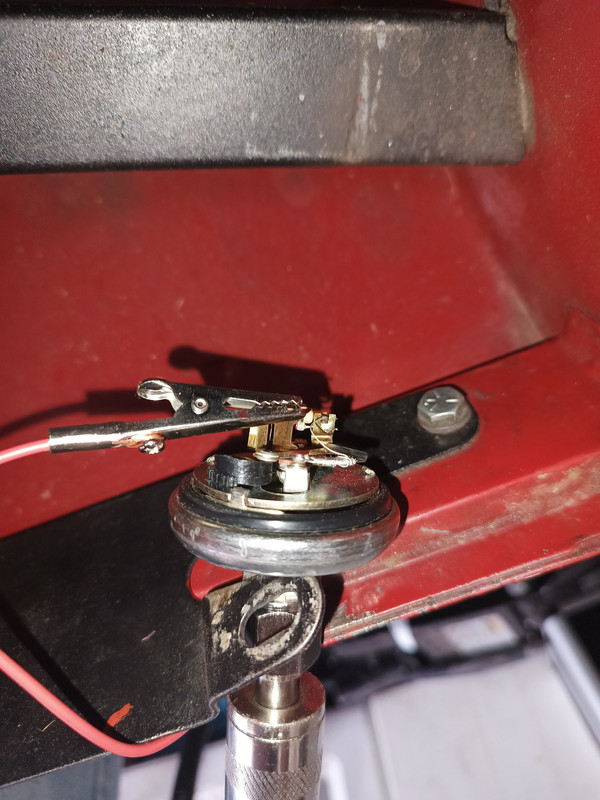
I prised the cap off a sender to see the gubbins inside. This is a bi-metal switch sender.
Having reset the contacts using the rotating black plastic adjuster so that the contacts were just apart at no pressure, I applied air pressure and waited for the gauge to respond.
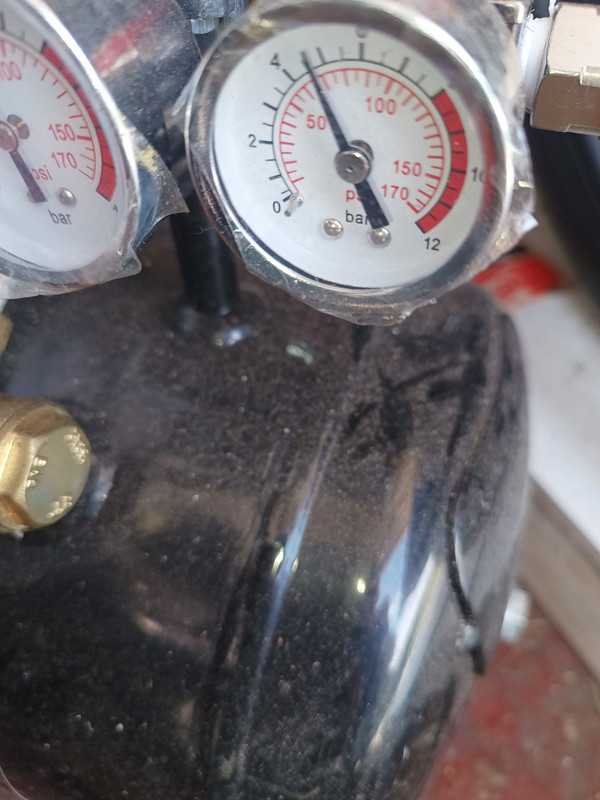
About 70 psi in the air line....
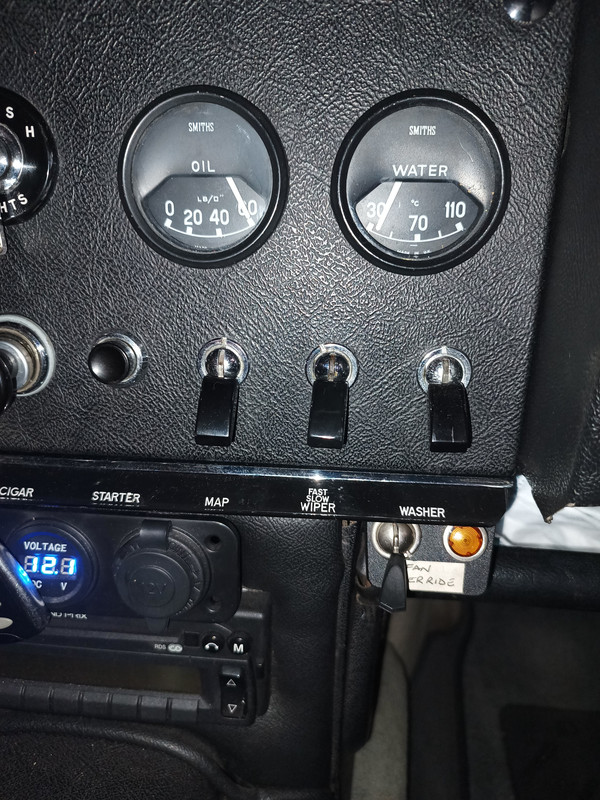
60 psi on the gauge.
This was one of the several senders which became unreliable. Not sure how long it would read this accurately. If I had been more accurate with the initial zeroing of the sender maybe the reading would have been more accurate. I don't know for sure.
As it is I'm not going to change the wildly optimistic sender currently on the engine. All I need to know is that the gauge reads 60 when I think the real pressure is around 40. As long as this is consistent, then oil pressure is fine. I don't need to know the actual pressure, just that is hasn't changed.

I prised the cap off a sender to see the gubbins inside. This is a bi-metal switch sender.
Having reset the contacts using the rotating black plastic adjuster so that the contacts were just apart at no pressure, I applied air pressure and waited for the gauge to respond.

About 70 psi in the air line....

60 psi on the gauge.
This was one of the several senders which became unreliable. Not sure how long it would read this accurately. If I had been more accurate with the initial zeroing of the sender maybe the reading would have been more accurate. I don't know for sure.
As it is I'm not going to change the wildly optimistic sender currently on the engine. All I need to know is that the gauge reads 60 when I think the real pressure is around 40. As long as this is consistent, then oil pressure is fine. I don't need to know the actual pressure, just that is hasn't changed.
Chris '67 S1 2+2
| Link: | |
| BBcode: | |
| HTML: | |
| Hide post links |
#38 Re: oil pressure sender calibration widget
I've done this with a couple of old senders and am using them in cars.
As you say the actual number is less important than a change.
I don't think that you can get replacement senders that actually work.
Andrew.
881824, 1E21538. 889457. 1961 4.3l Mk2. 1975 XJS. 1962 MGB
http://www.projectetype.com/index.php/the-blog.html
Adelaide, Australia
881824, 1E21538. 889457. 1961 4.3l Mk2. 1975 XJS. 1962 MGB
http://www.projectetype.com/index.php/the-blog.html
Adelaide, Australia
| Link: | |
| BBcode: | |
| HTML: | |
| Hide post links |
#39 Re: oil pressure sender calibration widget
What Chris has done in post #37 is very sensible. The gauge only needs to be roughly right from 10-70 psi as the oil light will tell you if you have dropped below ~3psi (panic!) and the oil relief valve will cap the pressure at about 70psi on cold startups. To be frank, the gauge can't be more accurate than this anyway.
For those wondering where my widget idea went, I considered it may be hard to produce one which was cheap enough for people to buy and simple enough for them to set up. The better you want it to work, the harder both of those targets become. I have mulled over an alternative which would be accurate at ten points on the scale, but not tell you any new information when you are between those ten set points. That might be far easier to produce, be economically viable and straightforward to calibrate. At double the component count, it'd read 20 set points, but as you'd have to calibrate each set point, you'd have to do that 20 times as you alter the pressure in your air line.
kind regards
Marek
For those wondering where my widget idea went, I considered it may be hard to produce one which was cheap enough for people to buy and simple enough for them to set up. The better you want it to work, the harder both of those targets become. I have mulled over an alternative which would be accurate at ten points on the scale, but not tell you any new information when you are between those ten set points. That might be far easier to produce, be economically viable and straightforward to calibrate. At double the component count, it'd read 20 set points, but as you'd have to calibrate each set point, you'd have to do that 20 times as you alter the pressure in your air line.
kind regards
Marek
| Link: | |
| BBcode: | |
| HTML: | |
| Hide post links |
#40 Re: oil pressure sender calibration widget
Marek, No oil warning light on mine. I think only on some early 3.8s and some early S3s.
Chris '67 S1 2+2
| Link: | |
| BBcode: | |
| HTML: | |
| Hide post links |





